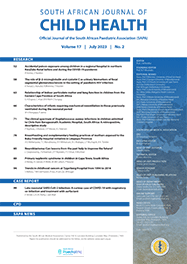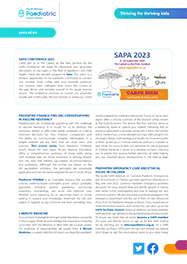Research

Physical activity and sedentary behaviours during pregnancy are associated with neonatal size at birth
Abstract
Background. Pregnancy is a crucial time to examine modifiable maternal behaviours associated with neonatal outcomes so that preventative measures can be taken against childhood obesity.
Objectives. This study aimed to examine the pathways through which maternal physical activity impacted neonatal size and body composition.
Methods. A subsample of participants who had objectively measured physical activity data were included from a pregnancy cohort study. Sociodemographic data were collected at the first visit during pregnancy. Gestational weight gain (GWG) was calculated at each visit, and the presence of gestational diabetes, hypertension and HIV were assessed. Physical activity was measured using a hip-worn triaxial accelerometer, at 14 - 18 weeks’ and 29 - 33 weeks’ gestation. At delivery, gestational age, birthweight and length were measured and neonatal body composition was analysed. A structural equation model (SEM) was run with either weight-to-length ratio (WLR) or fat mass index (FMI) as the outcome.
Results. A total of 84 participants were included in this study, and a subsample of neonates (n=45) also had FMI data. Most (66%) mothers presented as overweight or obese at their first visit, and gained on average 0.35 (19) kg per week. The SEM showed that only gestational age at delivery and sedentary time were positively associated with WLR. Step count was directly associated with GWG (ß=-0.02, p=0.01), and with gestational age (ß=0.16, p=0.04), and was therefore indirectly associated with decreased fetal abdominal circumference.
Conclusion. This study showed that increasing daily step count and decreasing sedentary behaviour could have beneficial effects on maternal health as well as delivery outcomes and neonatal size.
Authors' affiliations
A Prioreschi, SAMRC/Wits Developmental Pathways for Health Research Unit, Department of Paediatrics, School of Clinical Medicine, Faculty of Health Sciences, University of the Witwatersrand, Johannesburg, South Africa
S V Wrottesley, SAMRC/Wits Developmental Pathways for Health Research Unit, Department of Paediatrics, School of Clinical Medicine, Faculty of Health Sciences, University of the Witwatersrand, Johannesburg, South Africa
S A Norris, SAMRC/Wits Developmental Pathways for Health Research Unit, Department of Paediatrics, School of Clinical Medicine, Faculty of Health Sciences, University of the Witwatersrand, Johannesburg, South Africa; Global Health Research Institute, School of Human Development and Health, and NIHR Southampton Biomedical Research Centre, University of Southampton, UK
Full Text
Cite this article
Article History
Date published: 2022-02-01
Article Views
Full text views: 615

.jpg)



Comments on this article
*Read our policy for posting comments here